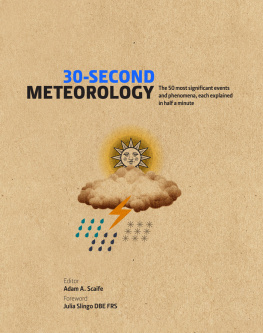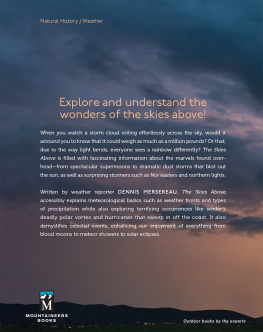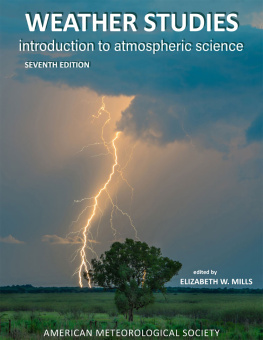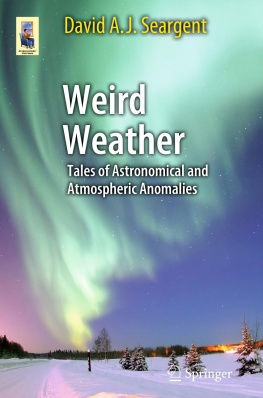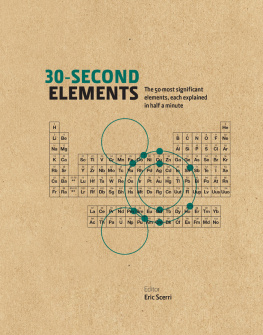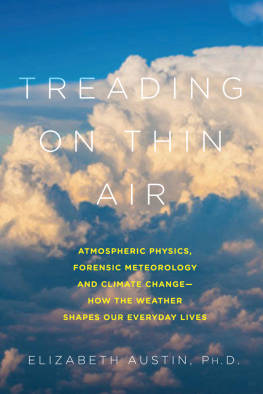30-SECOND
METEOROLOGY
The 50 most significant events and phenomena, each explained in half a minute
Editor
Adam A. Scaife
Foreword
Julia Slingo DBE FRS
Contributors
Edward Carroll
Leon Clifford
Chris K. Folland
Joanna D. Haigh
Brian Hoskins
Jeff Knight
Adam A. Scaife
Geoffrey K. Vallis
Illustrations
Nicky Ackland-Snow

The weather affects our daily decisions from what to wear, how to travel and when to leave the washing out. We know that blue skies bode well but why is the sky blue, does every cloud have a silver lining and is climate change an act of god or manmade?
30 Second Meteorology features 50 of the most significant events and phenomena to shower down from the skies, all explained without the bluster. Each entry is summarized in a mere half minute using just 300 words and one picture. Leading climate and atmospheric scientists present an expert account of fair weather and foul, from halcyon days to hurricanes, rainbows to rime frost, sunspots to supercells. Illustrated with engaging graphics and profiling seven key climate players, 30-Second Meteorology delivers the explanations you need to understand our restless atmosphere at lightning speed.
CONTENTS
FOREWORD
Professor Dame Julia Slingo DBE FRS
Our planets atmosphere is massively complex, and as a result the weather we experience varies hugely from place to place and over different times of the year. From heatwaves to storms to blizzards, weather and climate affect how we live and everything we do.
Through human ingenuity we have adapted to live with the weather: growing crops that will flourish, building homes that withstand local conditions, and planning our lives around the seasons. However, throughout history extreme weather events, such as droughts, floods and extreme cold, have challenged societies resilience, costing lives and livelihoods.
So it is natural that we have sought to understand our weather and climate what causes it to fluctuate and change over hours, weeks, seasons and years. And this endeavour has led to increasingly skilful weather forecasts and climate predictions that allow us to prepare for whats coming whether it is heavy, thundery rain this afternoon, a damaging wind storm later this week, the chance of a colder winter this year or more extreme heatwaves in the coming years as our climate warms.
Today, we live in a global economy, relying on global trade, efficient transport networks and resilient and reliable provision of food, energy and water. All of these systems are vulnerable to adverse weather and climate. The additional pressure of climate change creates a new set of circumstances and poses fresh challenges about how secure we will be in the future. More than ever, the weather and climate have considerable direct and indirect impacts on us our livelihoods, property, health, well-being and prosperity.
Through the application of scientific rigour and the use of cutting-edge technologies, such as satellites and supercomputers, the study of meteorology has revolutionized our understanding of the weather and climate we experience and enabled us to forecast its future behaviour with ever-increasing skill. From the global to local and from hours to decades, our understanding of weather and climate and the predictions we make enable us plan for the future. Dip into these pages to learn more about the science of meteorology and how our weather works.

Tackling the greenhouse
effect will test human ingenuity, making scientific knowledge and understanding of our planet and its atmosphere even more pressing during this century.
INTRODUCTION
Professor Adam A. Scaife
The atmosphere is inextricably linked with human endeavour. There are countless examples: the early loss of ships at sea in fierce storms; fortuitous Trade Winds that aided the crossing of vast oceans; devastating droughts, floods and hurricanes that still take thousands of lives even today; and the reliance on the regular onset of rainy seasons that sets the timing of agriculture the weather has an enormous impact on us all. It has shaped cultures and is even responsible for key turning points in history, such as the failure of Napoleons march into Russia in the grip of winter in the nineteenth century or the mass displacement of farmers in America due to the Dust Bowl drought of the 1930s.
These events and their consequences come about because the atmosphere is constantly changing. It varies on all timescales from the afternoon sunshine that brings us outdoors to the prolonged rains of the tropical monsoons. There are even decades where the weather keeps reverting back to similar behaviour summer after summer or winter after winter, only to change and be followed by years of the opposite. This apparently mysterious behaviour arises because the atmosphere is actually a constantly circulating fluid; trapped in a thin layer at the surface of our rotating Earth it swirls and flows just like the water in your bath tub. Apart from a lack of internal friction, the equations that govern the future behaviour of our weather and climate are almost the same as the equations that apply to the swirling fluid in your morning cup of coffee.
There are just six mathematical equations that encapsulate all of this and they can be written so concisely that they fit onto the back of a postcard. In fact, given their enormous significance, it is surprising they are not printed on T-shirts! These few equations that determine the fate of our weather also stem from well-established, or even old physics: they derive from Newtons laws of motion, the physics of heat and gases that was uncovered more than a century ago and the fact that air is neither created nor destroyed as it blows around with the wind. Yet despite the fact that we know so well the equations that govern what the future weather will be, they are still shrouded in uncertainty. This is because the problem is not like your school maths exercise where pencil and paper will do, instead the equations are intractable: they simply cannot be solved precisely. Even worse, they show that small changes can eventually give rise to big impacts through chaos and the revelation that a seagull flapping its wings can actually result in a hurricane months later fundamentally puts limits on any forecast. This is what makes meteorology so challenging and yet so compelling, and understanding the fluid that is our atmosphere is one of the most active remaining areas of terrestrial physics.

Harnessing the power
of the wind, constantly circulating the planet, is one early example of how the human race propelled itself towards becoming a global society.
Modern advances in understanding and the production of improved forecasts from hours to years ahead are now completely dependent on modern technology. A suite of scientific instruments measures various parameters of the Earths atmosphere. Arrays of environmental satellites continuously monitor the behaviour of the atmosphere and oceans and relay their measurements back to Earth: polar orbiters constantly circle the Earth in an almost north-south orbit at 800 kilometres altitude and geostationary satellites are sited 36,000 kilometres above the surface.
Next page
